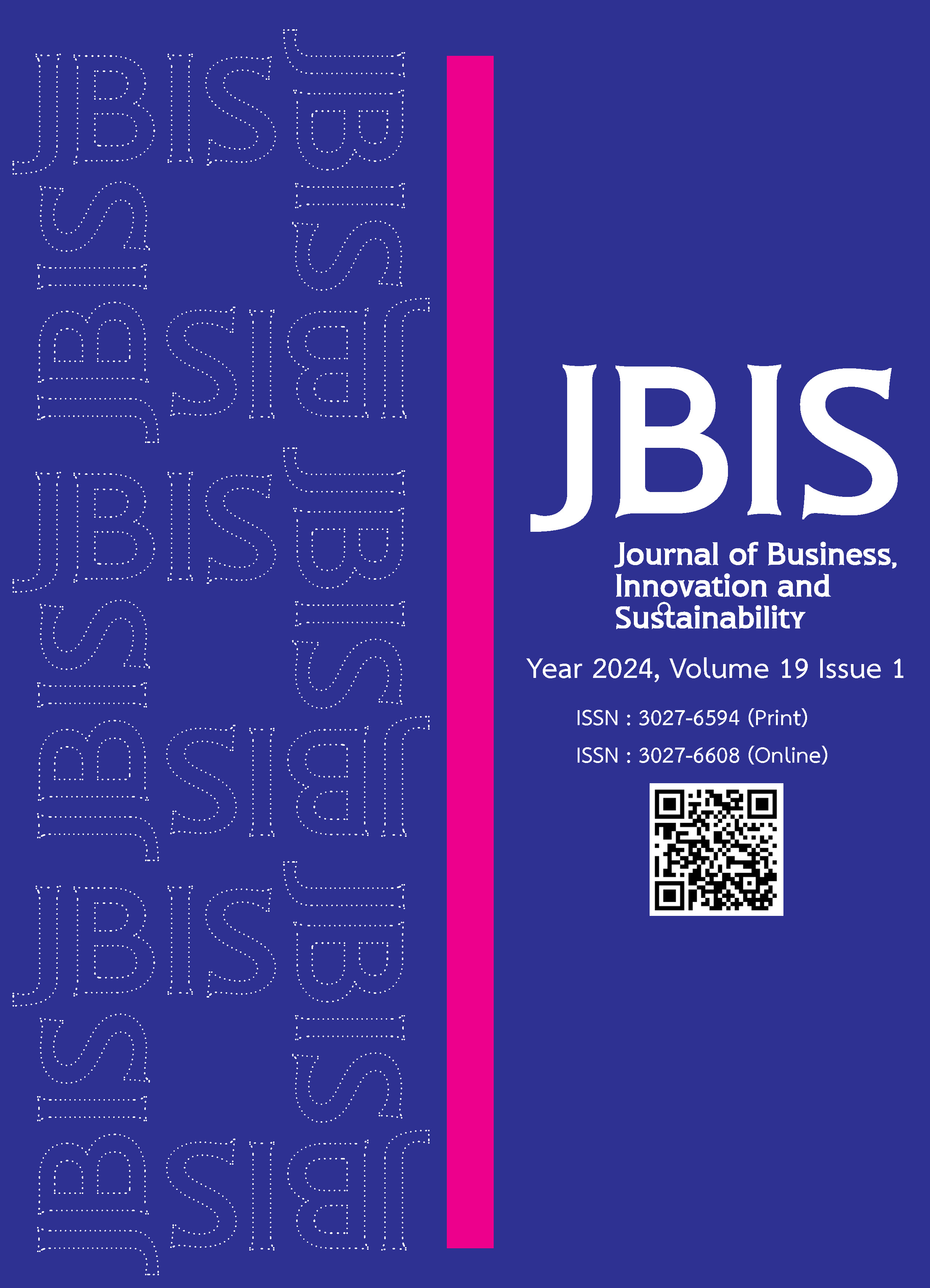The Influence of Lean Success Factors and Innovation on Competitiveness: A Structural Equation Modeling
Main Article Content
บทคัดย่อ
The primary goal of this research is to investigate the positive impact of Lean success factors and product innovation on competitiveness in terms of cost & price, products quality, and delivery. The information was gathered through questionnaires from 409 executives of automotive industry and analyzed using a structure equation model (SEM). The results correlated to the empirical evidence in a good level. CMIN/DF = 2.627, GFI = 0.949, NFI = 0.950, RFI = 0.916, IFI = 0.968, TLI = 0.946, CFI = 0.968, RMSEA = 0.063. According to the findings of this study, the Lean success factors had positive effects on competitiveness in terms of cost and price (0.65), products quality (0.19) but no statistically significant effects on delivery. Product innovation benefited from lean success factors (0.67). Product innovation improved competitiveness in terms of product quality (0.80) and delivery (0.90), but had no statistically significant effects on competitiveness in terms cost and price of Thai automotive industry.
Article Details

อนุญาตภายใต้เงื่อนไข Creative Commons Attribution-NonCommercial-NoDerivatives 4.0 International License.
เอกสารอ้างอิง
Achanga, P., Shehab, E., Rajkumar, R. and Nelder, G. (2006). Critical success factors for lean implementation within SMEs. Journal of Manufacturing Technology Management, 17(4), 460-471.
Blackmore, C. C., Bishop, R., Luker, S. and Williams, B. L. (2013). Applying lean methods to improve quality and safety in surgical sterile instrument processing. The Joint Commission Journal on Quality and Patient Safety, 39(3), 99-105.
Chen, H. and Taylor, R. (2009). (August 2-6, 2009). Exploring the impact of lean management on innovation capability. In Portland International Conference on Management of Engineering & Technology (pp. 826-834). Portland: IEEE.
Chou, P. (2015). Transformational leadership and employee’s behavioral support for organizational change. European Journal of Business and Management, 7(3), 110-122.
Chusri, P. (2013). The impacts of lean production system on the production efficiency in XYZ company limited. Independent Study, M.B.A., Kasetsart University, Bangkok.
Fornell, C. and Larcker, D. F. (1981). Evaluating structural equation models with unobservable variables and measurement error. Journal of marketing research, 18(1), 39-50.
Hair, J., Andreson, R., Tatham, R. and Black, W. (1998). Multivariate data analysis (5th ed.). New Jersey: Prentice-Hall Inc.
Hair, J., Black, W., Babin, B. and Anderson., R. E. (2010). Multivariate data analysis: A global perspective (7th ed.). New Jersey: Pearson Education.
Hines, P., Holweg, M. and Rich, N. (2004). Learning to evolve: a review of contemporary lean thinking. International Journal of Operations & Production Management, 24(10), 994-1011.
Ince, H., Imamoglu, S., Z., Keskin, H., Akgun, A. and Efe, M. N. (2013). The impact of ERP systems and supply chain management practices on firm performance: case of Turkish companies. Procedia-Social and Behavioral Sciences, 99, 1124-1133.
Jeyaraman, K. and Teo, L. K. (2010). A conceptual framework for critical success factors of lean Six Sigma: Implementation on the performance of electronic manufacturing service industry. International Journal of Lean Six Sigma, 1(3), 191-215.
Kline, R. B. (2015). Principles and practice of structural equation modeling (4th ed.). New York: The Guilford Press.
Koloszár, L. (2018). Opportunities of lean thinking in improving the competitiveness of the Hungarian SME sector. Management and Production Engineering Review, 9(6), 26-41.
Lam, L. W. (2012). Impact of competitiveness on salespeople's commitment and performance. Journal of Business Research, 65(9), 1328-1334.
Lewis, M. A. (2000). Lean production and sustainable competitive advantage. International Journal of Operations & Production Management, 20(8), 959-978.
Li, S., Ragu-Nathan, B., Ragu-Nathan, T. S. and Rao, S. S. (2006). The impact of supply chain management practices on competitive advantage and organizational performance. Omega, 34(2), 107-124.
Minoja, M., Zollo, M. and Coda, V. (2010). Stakeholder cohesion, innovation, and competitive advantage. Corporate Governance, 10(4), 395-405.
Mukdajaroenchai, K. (2013). Structure equation models of factor in lean production on performance in the automotive industry. Master thesis, M.B.A., Kasetsart University, Bangkok.
Nopakao, R. (2010). Lean manufacturing operating performance: Case study of production department OLIC (Thailand) limited. Independent Study, M.B.A., Kasetsart University, Bangkok.
Prado-Prado, J. C., García-Arca, J., Fernández-González, A. J. and Mosteiro-Añón, M. (2020). Increasing competitiveness through the implementation of lean management in healthcare. International Journal of Environmental Research and Public Health, 17(14), 4981.
Prajogo, D., Oke, A. and Olhager, J. (2016). Supply chain processes: Linking supply logistics integration, supply performance, lean processes and competitive performance. International Journal of Operations & Production Management, 36(2), 220-238.
Prajogo, D. and Olhager, J. (2012). Supply chain integration and performance: The effects of long-term relationships, information technology and sharing, and logistics integration. International Journal of Production Economics, 135(1), 514-522.
Organisation Internationale des Constructeurs d'Automobiles. (2021). Production 2020 Statistics. International Organization of Motor Vehicle Manufacturers. Retrieved June 7, 2021, from https://www.oica.net/category/production-statistics/2020-statistics/
Safiih, L. M. and Azreen, N. (2016). Confirmatory factor analysis approach: A case study of mathematics students’ achievement in timss. Malaysian Journal of Mathematical Sciences, 10, 41-51.
Suksmarnwong, N. and Wanarat, S. (2017). Critical success factors for lean implementation on operation performance and customer satisfaction of automotive part manufacturing. Nida Business Journal, 21, 109-128.
Suksmarnwong, N. and Wanarat, S. (2021). The causal relationship model of enterprise resource planning, supply chain performance, competitive advantage and organizational performance of Thai automotive parts industry Tier 1. Thammasat Business Journal, Journal of Business Administration, 44(169), 80-106.
The Office of Industrial Economics. (2018). Introduction to the automotive industry. Retrieved September 15, 2018, from http://www.oie.go.th/publications/EBookIndustBasicKnowledge
Udriyah, U., Tham, J. and Azam, S. (2019). The effects of market orientation and innovation on competitive advantage and business performance of textile SMEs. Management Science Letters, 9(9), 1419-1428.
Vorhies, D. W. and Morgan, N. A. (2005). Benchmarking marketing capabilities for sustainable competitive advantage. Journal of marketing, 69(1), 80-94.
Wanarat, S. (2018). A structural equation model of total quality management, innovation and supply chain performance. Business Administration and Economics review, 14(1), 105-127.
Wiriyagrochai, W. (2012). Factors relating with the success of lean manufacturing implementation in tissue converting department at ABC Co.,Ltd. Independent Study, M.B.A., Kasetsart University, Bangkok.
Wook Kim, S. (2006). Effects of supply chain management practices, integration and competition capability on performance. Supply Chain Management: An International Journal, 11(3), 241-248.


